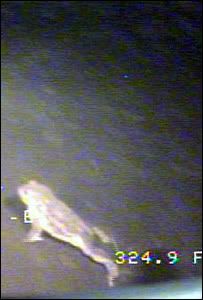
Exciting news from the Highlands and Islands region this week, as a team of scientists from MIT in Boston almost struck biological gold. One of the most infamous Cryptids out there (large and elusive animals), was again hunted for. The Loch Ness Monster has long puzzled people and inflamed opinions (like those realising you have to pay to visit the 'Nessie Experience', for example). The Beantown Boffins were completing a sonar map of the Loch, all 23 miles of it. Some project, as it contains more fresh water than all that in England and Wales combined. I'm not sure if they were specifically looking for giant marine dinosaurs - but they didn't find any. A 13,000yr old fossilised seabed was a pretty decent result, along with numerous seismic echoes of 'animal remains', and not Nessie, but a toad.
The Common Toad (Bufo bufo) was spotted by the MIT submersible, calmly waddling it's way through the muddy Loch sediment - or it was until the buzzing sub startled it with bright lights. Nothing unusual about that, you might think, as they are found in most European bodies of freshwater. The interesting thing was, this plucky Bufonid happened to be almost 100m (325ft) down in the cold, black water. Toads usually hunt in damp undergrowth or shallow lakes - amphibian experts are baffled as to what it was doing so deep underwater. It was the second "Hang on - that shouldn't be there!" nature story of the week, after the Cornish lobster fishermen who were checking their pots half a mile from Portreath Beach suddenly found a deer swimming past them.
Back in Scotland, Nessie enthusiasts were no doubt disappointed that the MIT expedition failed to find a slippery plesiosaur or two. With the possible exception of Bigfoot, the Loch Ness Monster is the most famous unseen creature in the world. It's certainly one of the oldest - the first alleged sighting was in 565AD by a Saint, no less. Columba (the patron saint of bookbinders), apparently rescued a hapless Pict by the name of Lugne, who was being attacked by a "ferocious monster". However, it seems Columba was a bit of a specialist in battling large creatures - the account of his life written by Adomnán of Iona includes several Herculean battles with massive beasties. He once killed a charging wild boar by shouting at it, apparently. Blessed are the bookbinders.
The 'Ultimate Nessie Site' (nessie.co.uk) has a list of sightings from 1871 onwards - "Mr D MacKenzie, October, log like object that moved off at speed". Some of them are a bit obtuse - "Gypsy woman, 1890's, place unknown, description unknown", some highly detailed - "Sir Murdoch MacDonald and son and one other observer, 18:00hrs, the 8th of August 1934, two humps, 15ft overall, moving slowly (about 100yds in five minutes)". I bet Sir Murdoch had a story to tell at dinner that evening. "I say chaps, you'll never guess what the boy, one other observer and I saw a few hours ago". The last recorded Nessie spotting event happened in 1998, so maybe the old girl has had enough of showing herself.
She hasn't always though. Monster fever peaked in the 1930's, at about the time a road was constructed around the banks of the loch. Sir Murdoch and others now had direct access to hilly vantage points, and many took advantage. The Daily Mail (in a highly untypical knee-jerk reaction) hired a big game hunter and media celebrity called Marmaduke Wetherell to roam the wilds for the beast. Within a few days, he had found a massive set of prints in the mud. Excitedly sent off to London's Natural History Museum for analysis, the area went crazy, thousands flocked to the small lochside towns. Floodlights were set up so people could search for Nessie at night. However, the experts looked at the tracks, and revealed that they were from a Hippopotamus - most likely the base of an umbrella stand.
The Official Loch Ness Monster site
Visit Loch Ness
Cryptomundo - the search for large animals